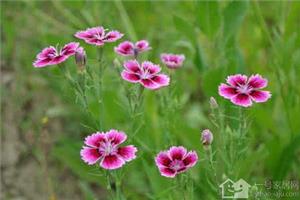Concrete collection and arrangement of culture methods of carnation flower
Grow in areas ranging from 10 meters to 2700 meters above sea level, and grow more in grasslands and hillside grasslands. Let's take a look at the specific culture methods of carnation flowers.

Concrete collection and arrangement of culture methods of carnation flower
Carnation is a kind of traditional famous flower, which has been cultivated in large quantities, which can be planted in pieces and can also be planted in pots to beautify the home environment. There are many varieties of carnation, bright colors, after pruning, the flowers are more colorful, very eye-catching, used to decorate the living environment is better. Carnation is a herbaceous flower with weak persistent roots, which is often cultivated as a 1-2-year-old plant. Maintenance is simple, 2-3 plants per pot can grow very well! Let's take a look at the breeding methods and matters needing attention of carnation!
1. Soil: Carnation requires fertile, loose, well-drained loam or sandy loam, which contains calcareous loam or sandy loam. It can be mixed with 6 parts of garden soil, 2 parts of compost and 2 parts of sandy soil.
2. Sunshine: the growing period of carnation requires sufficient light, placed in places with sufficient sunshine, and it is appropriate to scatter light in summer to avoid exposure to the hot sun. When the temperature is high, it should be shaded and cooled down.
3. Temperature: the most suitable temperature for the growth of carnation is 15: 20 ℃. When the temperature is high in summer, we should pay attention to proper shading and cooling. In winter, we should keep it in the greenhouse and keep the temperature above 12 ℃.

4. Watering: it is appropriate for carnation to keep the basin soil moist during its growth and development, such as watering too much and rotting roots. Watering should grasp the principle of not drying and not watering. Carnation sown in autumn should pay attention to anti-freezing and indoor maintenance from November to December, the water temperature should be close to room temperature, watering should be high, when the temperature is higher at noon, there should be no stagnant water on the leaves at night. The spring of the following year is poured back to green water, and the requirement is the same as in winter.
5. Fertilization: topdressing 2 or 3 times during the whole growing period, using rotten cake fertilizer or organic fertilizer. It is required to apply sufficient base fertilizer, 2-3 plants per pot.
6. Pruning: if you want more carnation blossoms, you must prune them in time. Pick the heart when the plant grows high, promote its branches, remove the leaf buds in time, and reduce the loss of nutrients. The trimmed carnation will blossom again. Carnation flowers can blossom again after pruning. If you want to bloom more, you can pick the heart and make it more branched, you must remove the axillary buds in time to reduce nutrient consumption.

6. Insect pests: Carnation is often harmed by scab and red spiders. The disease can be sprayed with 1500 times of 50% verapamil wettable powder and red spiders with 1500 times of omethoate EC.
During the growth period, the potted carnation should be maintained in a sunny and well-ventilated place to keep the basin soil moist and apply mature thin liquid fertilizer every 10 days or so. There are too many Rain Water in summer, pay attention to drainage and loosen the soil. Some leaf axillary buds should be removed in time before flowering, mainly to ensure that the top buds bloom. It is advisable to water less in winter, such as keeping the temperature at 5-8 degrees, blooming continuously in winter and spring.

Note:
1) replenish water and shade the sun
Ensure 6-8 hours of light every day. At the height of summer, the carnation flower is in a semi-dormant state, so we should pay attention to avoid the hot sun exposure. Avoid stagnant water in the basin, otherwise the roots are easy to rot.
2) Prevention and control of diseases and insect pests
There are not many diseases and insect pests of carnation, and the common ones are calyx rot, scab, gray mold, bud rot and root rot. Once the disease occurs, clean up the diseased plant in time, and spray chemical control, can not be neglected.
- Prev

The Culture method of Carnation matters needing attention in Carnation Culture
The Culture method of Carnation matters needing attention in Carnation Culture
- Next

Matters needing attention in indoor culture of flowers and plants common matters needing attention in flower culture
Matters needing attention in indoor culture of flowers and plants common matters needing attention in flower culture
Related
- Wuhan Hospital Iron Tree Blooming Result Was Instantly Frightened by the Gardener Master
- Which variety of camellia is the most fragrant and best? Which one do you like best?
- What is the small blue coat, the breeding methods and matters needing attention of the succulent plant
- Dormancy time and maintenance management of succulent plants during dormancy
- Minas succulent how to raise, Minas succulent plant pictures
- What are the varieties of winter succulent plants
- How to raise succulent plants in twelve rolls? let's take a look at some experience of breeding twelve rolls.
- Attention should be paid to water control for succulent plants during dormant period (winter and summer)
- Watering experience of twelve rolls of succulent plants
- Techniques for fertilizing succulent plants. An article will let you know how to fertilize succulent plants.

